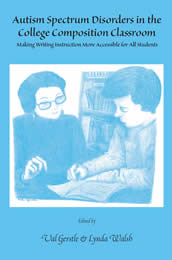Autism Spectrum Disorders in the College Composition Classroom: Making Writing Instruction More Accessible for All Students, edited by Val Gerstle & Lynda Walsh. ISBN-13: 978-0-87462-072-6. ISBN-10: 0-87462-072-4. Paper. 150 pp. $20. Bibliography. Index. Illustrated
Growing numbers of Americans with diagnoses of high-functioning Autism Spectrum Disorders (ASD) are enrolling at universities across the country. This is great news for the diversity of higher education. Nonetheless, students with ASD frequently encounter challenges when they sign up for their required composition courses. Group work, empathizing with audiences, using metaphors in writing—these are just a few of the standard curricular situations that have alerted students, instructors, and administrators to the need for better strategies for accommodating the unique perspectives of ASD in composition instruction. This volume represents a start toward finding those strategies. The contributors bring decades of classroom experience to bear on questions such as “How do we design assignments that encourage students with ASD to play to their strengths as they work to improve their writing?” “How can administrators support students with ASD in writing classes?” and “How should composition instructors interpret reports of research on ASD and writing?” The overarching theme of the essays presented here is that ASD extends an invitation to college composition instructors to craft a learning environment that better serves all students.
Each college disability office, English department, & writing center should have a copy.” Gena Barnhill, PhD, NCSP, BCBA, Director of Special Education Programs, School of Education & Human Development, Lynchburg College“A praxis-changing supplement to the scholarship in the field, this book creates frameworks for developing the writing skills of students with Autism Spectrum Disorders through practical classroom suggestions. Keep this book nearby! Educators and students alike will find it comes in handy in prepping for the composition classroom. Using the pragmatic teaching examples will bring out the wonderful potential for students with ASD to relate to their audiences and effectively communicate their viewpoints.” Gary Vaughn, Associate Professor of English, University of Cincinnati
Val Gerstle has spent many years teaching Basic English and Freshman English at University of Cincinnati, and has been published in The House of Your Dream: An International Collection of Prose Poetry, The Best of the Prose Poem: An International Journal, and over 40 literary magazines. Val has a PhD in English and Comparative Literature, an MFA in Creative Writing, and a BFA in Fine Arts. She lives in Cincinnati with her “significant other” and his autistic son.
Lynda Walsh, Associate Professor of English at the University of Nevada, Reno, teaches a range of writing courses and conducts research on the rhetoric of science and the role of technology in the writing classroom.
Contents
Introduction Lynda Walsh
Autism Spectrum Disorders in College Composition ~ 7
Section I: Accommodation
1 Marcia Ribble
Basic Writing Students with Autism in the College Classroom ~ 15
2 Katherine V. Wills
“I just felt kinda invisible”: Accommodations for Learning Disabled Students in the Composition Classroom~ 35
3 April Mann
Structure & Accommodation: Autism and the Writing Center ~ 45
4 Lynda Walsh & Cheryl Olman
Recommended Approaches to the Neuroimaging Literature on Autism Spectrum Disorders (ASD) for Teachers of Writing ~ 75
Section II: Pedagogy
5 Kim Freeman
Channeling the Enthusiasm: Two Narratives of Teaching Students with Asperger’s Symdrome in Writing & Literature Classes, with Questions & Reflections ~ 89
6 Val Gerstle
Reaching the College Composition Student with Autism through the Cartoon-Enhanced Classroom ~ 99
7 Muriel Cunningham
Helping Autistic Students Improve Written Communication Skills through Visual Images ~ 123
8 Jennifer McClinton-Temple
“Well, Not Exactly”: Asperger’s & the Integration of Outside Sources ~ 137
About the Authors ~ 144
Index ~ 147






